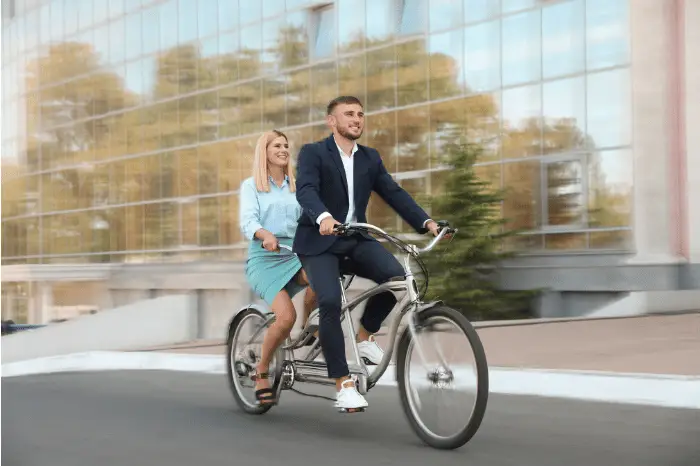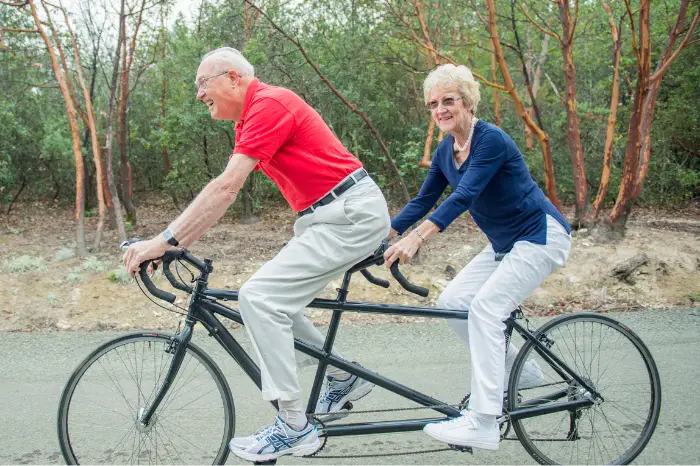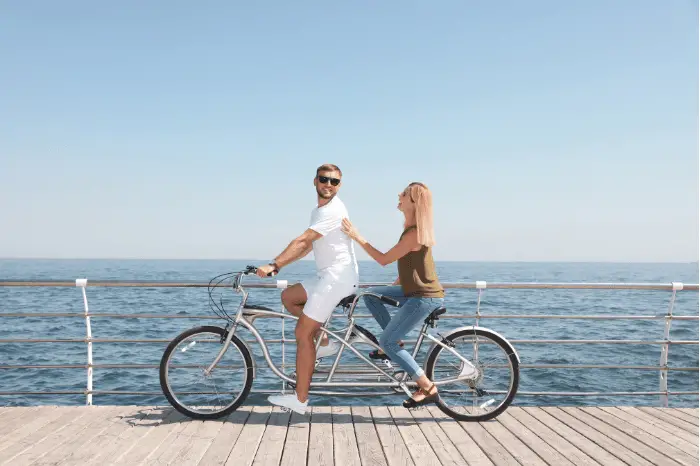
Riding a tandem bike can be a fun and unique experience, but it can also be a bit intimidating if you’ve never done it before. Tandem bikes are designed for two people to ride together, with one person in front (the captain) and the other person behind (the stoker). The captain is responsible for steering and braking, while the stoker helps to pedal and maintain balance.
If you’re new to tandem biking, it’s important to understand the basics before you hit the road. First, you’ll need to find a partner who is willing to ride with you. It’s best to choose someone who is roughly the same height and weight as you, as this will help to ensure that the bike is balanced and stable.
Once you have your partner, you’ll need to adjust the tandem bike to fit both of you. This may involve adjusting the seat height, handlebars, and pedals to ensure that you are both comfortable and can reach everything you need to. With a little practice and patience, you’ll soon be ready to hit the road and enjoy the unique experience of riding a tandem bike.
Choosing the Right Tandem Bike
If you’re planning to ride a tandem bike, you need to make sure that you choose the right one. Here are some things to consider when choosing a tandem bike:
Size and Fit
The most important factor to consider when choosing a tandem bike is the size and fit. Tandem bikes come in different sizes, just like regular bikes. It’s important to choose a tandem bike that fits both you and your partner comfortably.
Make sure that the captain (the person who sits in front and steers the bike) and the stoker (the person who sits in the back and pedals) have a comfortable fit. The captain should be able to reach the handlebars comfortably, while the stoker should be able to pedal comfortably without feeling cramped.
Types of Tandem Bikes
There are different types of tandem bikes available, each with its unique features. Here are some common types of tandem bikes:
- Road Tandem Bikes: These are designed for speed and efficiency, and are often used for racing or touring. They have lightweight frames and narrow tires.
- Cruiser Tandem Bikes: These are ideal for leisurely rides, scenic trips, and casual cycling adventures, offering a unique way for two riders to enjoy the experience of cycling together in a relaxed and comfortable manner.
- Electric Tandem Bikes: These also known as e-tandem bikes, combine the cooperative riding experience of a tandem with the assistance of electric power. These bikes are designed for two riders who pedal together, but they are equipped with an electric motor to provide additional propulsion.
- Recumbent Tandem Bikes: These have a reclined seating position, which can be more comfortable for some riders. They are often used for touring or long-distance rides.
Consider what type of riding you’ll be doing before choosing a tandem bike. Overall, choosing the right tandem bike is essential for a comfortable and enjoyable ride. Make sure to consider the size and fit, as well as the type of tandem bike that will best suit your needs.
Fundamentals of Tandem Riding
Riding a tandem bike is a fun and unique experience that requires teamwork and coordination between two riders. Whether you are a seasoned cyclist or a beginner, tandem riding can be a rewarding activity if you follow some basic guidelines.
Rider Positions
The two riders on a tandem bike are known as the captain (front rider) and the stoker (rear rider). The captain is responsible for steering and braking, while the stoker’s role is to pedal in sync with the captain. Both riders need to communicate with each other and work together to maintain balance and stability.
When riding a tandem bike, the captain should sit in a slightly leaned forward position with their hands on the handlebars. The stoker should sit in an upright position with their hands on the stoker bars located behind the captain’s seat. The stoker should also keep their feet on the pedals and avoid touching the ground with their feet while the bike is in motion.
Mounting and Dismounting

Mounting and dismounting a tandem bike requires coordination between the two riders. The easiest way for the captain to get on a tandem bike is by standing over the bike with one foot on each side of the frame and then sitting down on the captain’s seat. The stoker should then get on the bike by stepping onto the pedals and swinging their leg over the frame to sit on the stoker seat.
When it comes to dismounting, the stoker should first take their feet off the pedals and place them on the ground. The captain should then stop the bike and hold it steady while the stoker dismounts by swinging their leg over the frame and stepping off the bike. The captain should then dismount by standing over the bike and stepping off with one foot on each side of the frame.
By following these basic guidelines for rider positions, mounting, and dismounting, you can ensure a safe and enjoyable tandem riding experience.
Communication and Coordination
Riding a tandem bike requires a high level of communication and coordination between the captain and the stoker. Without proper communication, the ride can quickly become uncomfortable and dangerous. Here are some essential tips to help you communicate and coordinate effectively while riding a tandem bike.
Signaling and Commands
Clear and concise communication is essential while riding a tandem bike. The captain should use verbal and nonverbal signals to communicate with the stoker. Some common hand signals include pointing left or right, indicating a turn, and pointing down, indicating a bump or obstacle on the road.
In addition to hand signals, there are four common commands that the captain should use to facilitate communication and coordination. These commands are “on,” “off,” “bump,” and “shift.” When either side of the pedal is in the power position as decided by the captain, an ‘On’ command is a cue to start pedaling. The ‘Off’ command is used to stop pedaling. The ‘Bump’ command is used to warn the stoker of a bump or obstacle on the road. The ‘Shift’ command is used to indicate a gear change.
Pedaling in Sync

Pedaling in sync is crucial for a smooth and comfortable ride. The captain should set the pace, and the stoker should match the cadence. The stoker should avoid sudden stops or changes in pedaling speed, which can cause the bike to wobble. The captain should also avoid sudden changes in speed or direction, which can be dangerous for the stoker.
To help maintain a consistent cadence, the captain should communicate with the stoker and adjust the pace as needed. The stoker should also communicate with the captain if they need a break or if they are experiencing discomfort.
Overall, effective communication and coordination are key to a successful tandem bike ride. By using clear signals and commands and pedaling in sync, you can enjoy a smooth and comfortable ride with your partner.
Safety Measures
When it comes to riding a tandem bike, safety should always be a top priority. Here are some safety measures to keep in mind before you hit the road.
Helmet and Gear
Wearing a helmet is a must when riding a tandem bike. Make sure that everyone on the bike wears a properly fitting helmet to reduce the risk of head injuries in case of an accident. Additionally, protective gear such as gloves and padded shorts can help prevent scrapes and bruises.
Braking and Turning
Braking and turning on a tandem bike requires coordination between both riders. Make sure that the captain communicates braking and turning intentions to the stoker to avoid sudden stops or turns that can cause accidents. When braking, apply pressure gradually to avoid skidding. When turning, lean the bike in the direction of the turn and communicate with your partner to ensure a smooth turn.
By following these safety measures, you can ensure a safe and enjoyable tandem bike ride. Remember to always stay alert and aware of your surroundings to avoid accidents.
Practicing and Improving
Riding a tandem bike can be challenging at first, but with practice, you can improve your skills and become more comfortable on the bike. Here are some tips on how to practice and improve your tandem bike riding abilities.

Starting and Stopping
Starting and stopping a tandem bike can be tricky, especially if you and your partner have different riding styles. To start, make sure that both riders are seated on the bike with their feet on the pedals. The captain should hold the handlebars and keep the bike steady while the stoker gets into position. Once the stoker is ready, the captain can start pedaling and the bike will move forward.
To stop, both riders should apply the brakes at the same time. The captain should also communicate with the stoker to make sure they are both ready to stop.
Navigating Traffic
Navigating traffic on a tandem bike can be challenging, but there are some things you can do to make it easier. First, make sure that both riders are aware of their surroundings and communicate with each other about any obstacles or hazards. The captain should also be aware of the stoker’s abilities and adjust their riding style accordingly.
When riding in traffic, it’s important to stay visible and communicate with other drivers and cyclists. Use hand signals to indicate turns and stops, and make sure that you and your partner are wearing bright, reflective clothing.
Overall, the key to improving your tandem bike riding skills is practice. Start with short rides and gradually increase your distance and speed as you become more comfortable on the bike. With time and dedication, you can become a confident and skilled tandem bike rider.
Frequently Asked Questions
What are the benefits of riding a tandem bike compared to a solo bike?
Riding a tandem bike has several benefits over a solo bike. Tandem bikes are great for couples, friends, or family members who want to ride together and enjoy the scenery. Tandem bikes are also great for people who want to share the workload of pedaling, especially on long rides or hilly terrain. Additionally, riding a tandem bike can help improve communication and teamwork skills between partners.
How do you effectively communicate with your partner while riding a tandem bike?
Communication is key when riding a tandem bike. It’s important to establish clear signals and cues with your partner before starting your ride. Some common signals include tapping your partner’s shoulder to signal a turn, pointing in the direction of the turn, or using hand signals to indicate stopping or slowing down. It’s also important to communicate about changes in speed, terrain, or other obstacles on the road.
What are the key safety tips for beginners on a tandem bicycle?
Safety is a top priority when riding a tandem bike. It’s important to wear helmets and other protective gear, follow traffic laws and signals, and stay alert and aware of your surroundings. Additionally, it’s important to practice good communication and teamwork skills with your partner, especially when making turns or navigating tricky terrain.
How does the weight distribution affect the handling of a tandem bike?
Weight distribution is a crucial factor in the handling of a tandem bike. The heavier rider should sit in the front (captain) position, while the lighter rider should sit in the back (stoker) position. This helps distribute weight evenly and provides better stability and control over the bike.
Can a tandem bike accommodate riders with different skill levels?
Yes, a tandem bike can accommodate riders with different skill levels. However, it’s important to choose a bike that is appropriate for both riders’ skill levels and experience. Additionally, it’s important to communicate clearly and work together as a team to ensure a safe and enjoyable ride.
What should you consider when choosing a tandem bike for purchase or rental?
When choosing a tandem bike, it’s important to consider factors such as frame size, weight, and material, as well as the type of riding you plan to do. You should also consider the skill level and experience of both riders, as well as any special needs or preferences. It’s a good idea to test-ride several different models before making a decision and to seek advice from a knowledgeable bike shop or rental service.
